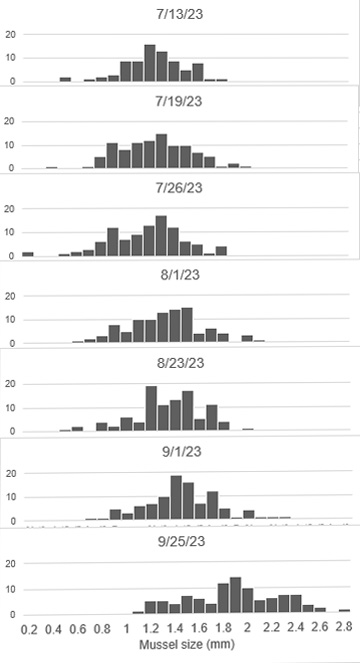 Fourth Cliff at the mouth of the North and South Rivers is part of the designated North River Important Bird Area (IBA). The barrier beach there provides feeding and staging habitat for migrating shorebirds. Among the food that migratory shorebirds consume are small mussels (Mytilus edulis). The blue mussel beds in the North and South Rivers have significantly declined since the 1980s, initiated by a limited commercial harvest. However, in recent years other causes like invasive crab predation have possibly played a role in reducing the abundance of mussels in the rivers.
Fourth Cliff at the mouth of the North and South Rivers is part of the designated North River Important Bird Area (IBA). The barrier beach there provides feeding and staging habitat for migrating shorebirds. Among the food that migratory shorebirds consume are small mussels (Mytilus edulis). The blue mussel beds in the North and South Rivers have significantly declined since the 1980s, initiated by a limited commercial harvest. However, in recent years other causes like invasive crab predation have possibly played a role in reducing the abundance of mussels in the rivers.
Food availability for migrating shorebirds is crucial as these birds head south from their nesting territories. In particular, Rufa Red Knots (Calidris canutus rufa), a federally-designated Threatened species, rely heavily on blue mussel spat as a primary food source during their fall southward migration. The decline of available food during fall migration and a general decline in population may have contributed to fewer knots observed in the Third and Fourth Cliff areas of the North and South Rivers. Mass Audubon has been monitoring Red Knot and other shorebirds during their fall migration at Third and Fourth cliffs since 2015. Historically, Red Knot numbers in this area were in the hundreds, with 2,800 recorded in 1981.
In addition to providing a crucial foraging stopover for Red Knot and other migrating shorebirds, blue mussel beds stabilize shorelines, positively impact water quality and the ecology of the estuary, and may provide an additional local shellfish resource. As storms increase in frequency and strength due to climate change and rising sea levels, protecting salt marsh shorelines is becoming even more vital.
The NSRWA and MassBays piloted efforts to enhance blue mussels in the rivers in 2014 and 2015, including testing out spat collection systems, raising small groups of benthic mussels, and transferring larger adult mussels from docks to the benthic environment. This effort was reinitiated in 2022 with the thought that the issue with food availability was one of spat supply, and by moving mussels that were too large to be eaten to Fourth Cliff, an abundant supply of small mussels would be available for foraging.
 In 2023, our summer interns, led by Molly Frattasio, conducted surveys at Fourth Cliff and discovered that there were abundant small mussels but the mussels were being fed upon by gulls as well as some green crabs. This shifted our thinking to consider whether the problem is not one of spat supply but one of spat survival for long enough into the fall to provide food during the migratory period. The interns, along with our Habitat and GIS Field Technician, Beth Howard, conducted seven surveys of a mussel bed off Fourth Cliff, measuring mussels and also mapping the border of the mussel bed. The mussel bed is approximately 0.58 acres and is located on the north side of the western end of Fourth Cliff. The largest cohort of mussels grew ~ 0.7 mm over the course of the measurement period (see graph).
In 2023, our summer interns, led by Molly Frattasio, conducted surveys at Fourth Cliff and discovered that there were abundant small mussels but the mussels were being fed upon by gulls as well as some green crabs. This shifted our thinking to consider whether the problem is not one of spat supply but one of spat survival for long enough into the fall to provide food during the migratory period. The interns, along with our Habitat and GIS Field Technician, Beth Howard, conducted seven surveys of a mussel bed off Fourth Cliff, measuring mussels and also mapping the border of the mussel bed. The mussel bed is approximately 0.58 acres and is located on the north side of the western end of Fourth Cliff. The largest cohort of mussels grew ~ 0.7 mm over the course of the measurement period (see graph).
Next year, we hope to conduct a more comprehensive survey of the mussels at Fourth Cliff, and continue to partner with Mass Audubon along with Manomet (Center for Conservation Sciences) to determine if a larger scale effort can be made at not only Fourth Cliff but also at Third Cliff to restore the Red Knot and its food source, the blue mussel.

